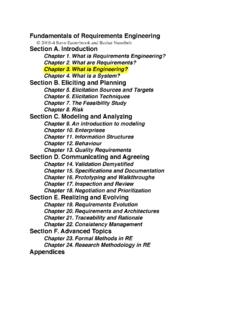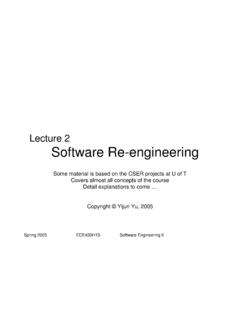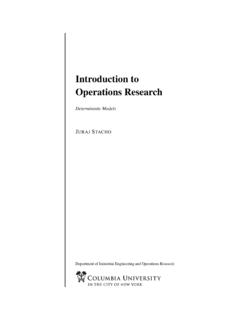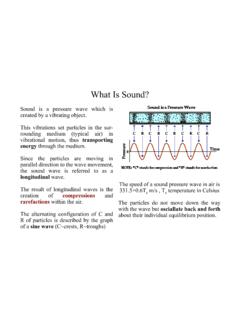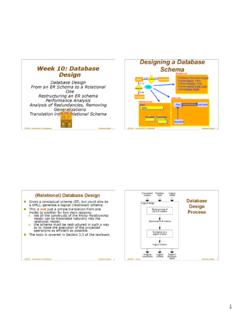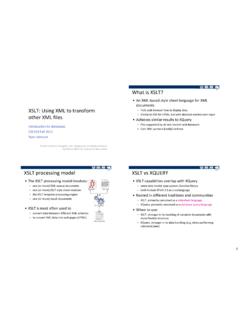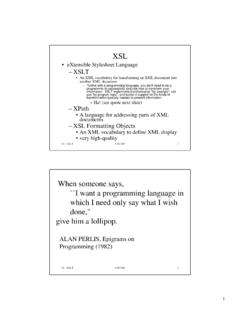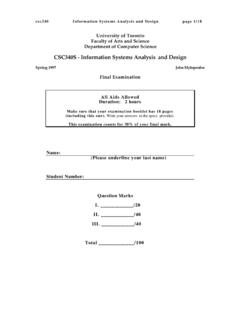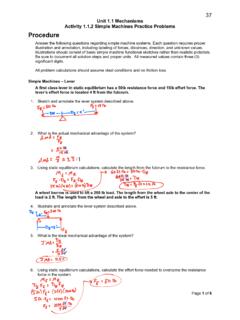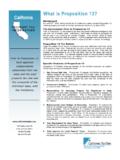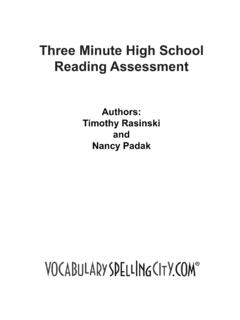Transcription of Dropout: A Simple Way to Prevent Neural Networks from …
1 Journal of Machine Learning Research 15 (2014) 1929-1958 Submitted 11/13; Published 6/14 Dropout: A Simple Way to Prevent Neural Networks fromOverfittingNitish of Computer ScienceUniversity of Toronto10 Kings College Road, Rm 3302 Toronto, Ontario, M5S 3G4, :Yoshua BengioAbstractDeep Neural nets with a large number of parameters are very powerful machine learningsystems. However, overfitting is a serious problem in such Networks . Large Networks are alsoslow to use, making it difficult to deal with overfitting by combining the predictions of manydifferent large Neural nets at test time. Dropout is a technique for addressing this key idea is to randomly drop units (along with their connections) from the neuralnetwork during training. This prevents units from co-adapting too much. During training,dropout samples from an exponential number of different thinned Networks .
2 At test time,it is easy to approximate the effect of averaging the predictions of all these thinned networksby simply using a single unthinned network that has smaller weights. This significantlyreduces overfitting and gives major improvements over other regularization methods. Weshow that dropout improves the performance of Neural Networks on supervised learningtasks in vision, speech recognition, document classification and computational biology,obtaining state-of-the-art results on many benchmark data : Neural Networks , regularization, model combination, deep learning1. IntroductionDeep Neural Networks contain multiple non-linear hidden layers and this makes them veryexpressive models that can learn very complicated relationships between their inputs andoutputs. With limited training data, however, many of these complicated relationshipswill be the result of sampling noise, so they will exist in the training set but not in realtest data even if it is drawn from the same distribution.
3 This leads to overfitting and manymethods have been developed for reducing it. These include stopping the training as soon asperformance on a validation set starts to get worse, introducing weight penalties of variouskinds such as L1 and L2 regularization and soft weight sharing (Nowlan and Hinton, 1992).With unlimited computation, the best way to regularize a fixed-sized model is toaverage the predictions of all possible settings of the parameters, weighting each setting byc 2014 Nitish Srivastava, Geoffrey Hinton, Alex Krizhevsky, Ilya Sutskever and Ruslan , Hinton, Krizhevsky, Sutskever and Salakhutdinov(a) Standard Neural Net(b) After applying 1:Dropout Neural Net : A standard Neural net with 2 hidden :An example of a thinned net produced by applying dropout to the network on the units have been posterior probability given the training data.
4 This can sometimes be approximated quitewell for Simple or small models (Xiong et al., 2011; Salakhutdinov and Mnih, 2008), but wewould like to approach the performance of the Bayesian gold standard using considerablyless computation. We propose to do this by approximating an equally weighted geometricmean of the predictions of an exponential number of learned models that share combination nearly always improves the performance of machine learning meth-ods. With large Neural Networks , however, the obvious idea of averaging the outputs ofmany separately trained nets is prohibitively expensive. Combining several models is mosthelpful when the individual models are different from each other and in order to makeneural net models different, they should either have different architectures or be trainedon different data.
5 Training many different architectures is hard because finding optimalhyperparameters for each architecture is a daunting task and training each large networkrequires a lot of computation. Moreover, large Networks normally require large amounts oftraining data and there may not be enough data available to train different Networks ondifferent subsets of the data. Even if one was able to train many different large Networks ,using them all at test time is infeasible in applications where it is important to is a technique that addresses both these issues. It prevents overfitting andprovides a way of approximately combining exponentially many different Neural networkarchitectures efficiently. The term dropout refers to dropping out units (hidden andvisible) in a Neural network . By dropping a unit out, we mean temporarily removing it fromthe network , along with all its incoming and outgoing connections, as shown in Figure choice of which units to drop is random.
6 In the simplest case, each unit is retained witha fixed probabilitypindependent of other units, wherepcan be chosen using a validationset or can simply be set at , which seems to be close to optimal for a wide range ofnetworks and tasks. For the input units, however, the optimal probability of retention isusually closer to 1 than to withprobabilitypw-(a) At training timeAlwayspresentpw-(b) At test timeFigure 2:Left: A unit at training time that is present with probabilitypand is connected to unitsin the next layer with : At test time, the unit is always present andthe weights are multiplied byp. The output at test time is same as the expected outputat training dropout to a Neural network amounts to sampling a thinned network fromit. The thinned network consists of all the units that survived dropout (Figure 1b).
7 Aneural net withnunits, can be seen as a collection of 2npossible thinned Neural Networks all share weights so that the total number of parameters is stillO(n2), orless. For each presentation of each training case, a new thinned network is sampled andtrained. So training a Neural network with dropout can be seen as training a collection of 2nthinned Networks with extensive weight sharing, where each thinned network gets trainedvery rarely, if at test time, it is not feasible to explicitly average the predictions from exponentiallymany thinned models. However, a very Simple approximate averaging method works well inpractice. The idea is to use a single Neural net at test time without dropout. The weightsof this network are scaled-down versions of the trained weights. If a unit is retained withprobabilitypduring training, the outgoing weights of that unit are multiplied bypat testtime as shown in Figure 2.
8 This ensures that for any hidden unit theexpectedoutput (underthe distribution used to drop units at training time) is the same as the actual output attest time. By doing this scaling, 2nnetworks with shared weights can be combined intoa single Neural network to be used at test time. We found that training a network withdropout and using this approximate averaging method at test time leads to significantlylower generalization error on a wide variety of classification problems compared to trainingwith other regularization idea of dropout is not limited to feed-forward Neural nets. It can be more generallyapplied to graphical models such as Boltzmann Machines. In this paper, we introducethe dropout Restricted Boltzmann Machine model and compare it to standard RestrictedBoltzmann Machines (RBM). Our experiments show that dropout RBMs are better thanstandard RBMs in certain paper is structured as follows.
9 Section 2 describes the motivation for this 3 describes relevant previous work. Section 4 formally describes the dropout 5 gives an algorithm for training dropout Networks . In Section 6, we present ourexperimental results where we apply dropout to problems in different domains and compareit with other forms of regularization and model combination. Section 7 analyzes the effect ofdropout on different properties of a Neural network and describes how dropout interacts withthe network s hyperparameters. Section 8 describes the Dropout RBM model. In Section 9we explore the idea of marginalizing dropout. In Appendix A we present a practical guide1931 Srivastava, Hinton, Krizhevsky, Sutskever and Salakhutdinovfor training dropout nets. This includes a detailed analysis of the practical considerationsinvolved in choosing hyperparameters when training dropout MotivationA motivation for dropout comes from a theory of the role of sex in evolution (Livnat et al.)
10 ,2010). Sexual reproduction involves taking half the genes of one parent and half of theother, adding a very small amount of random mutation, and combining them to produce anoffspring. The asexual alternative is to create an offspring with a slightly mutated copy ofthe parent s genes. It seems plausible that asexual reproduction should be a better way tooptimize individual fitness because a good set of genes that have come to work well togethercan be passed on directly to the offspring. On the other hand, sexual reproduction is likelyto break up these co-adapted sets of genes, especially if these sets are large and, intuitively,this should decrease the fitness of organisms that have already evolved complicated co-adaptations. However, sexual reproduction is the way most advanced organisms possible explanation for the superiority of sexual reproduction is that, over the longterm, the criterion for natural selection may not be individual fitness but rather mix-abilityof genes.
